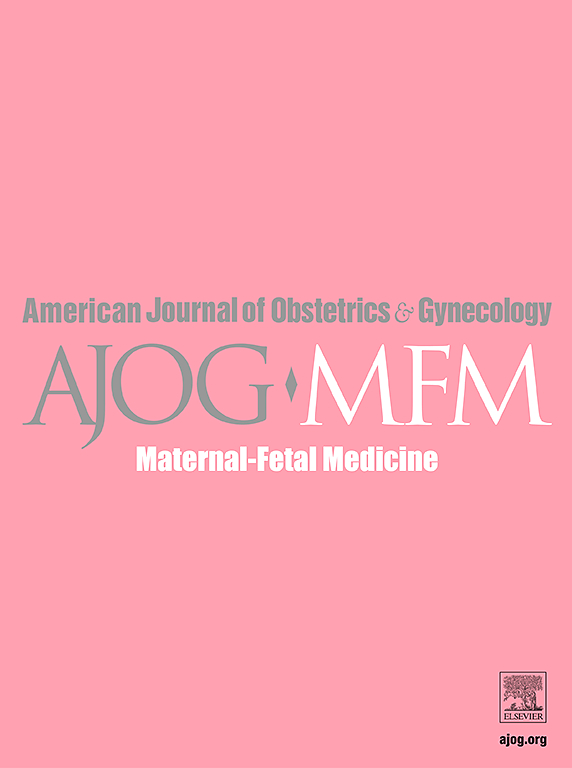Insight into the abnormal cardiotocographic patterns following neuraxial analgesia for pain management in labor
IF 3.1
2区 医学
Q1 OBSTETRICS & GYNECOLOGY
American Journal of Obstetrics & Gynecology Mfm
Pub Date : 2025-07-29
DOI:10.1016/j.ajogmf.2025.101747
引用次数: 0
Abstract
BACKGROUND
Neuraxial analgesia (NA) is widely used for pain management in labor but may be associated with abnormal fetal heart rate patterns, including prolonged decelerations.
OBJECTIVE
To investigate decelerations and fetal bradycardia following neuraxial analgesia (NA; epidural, combined spinal-epidural, or spinal) in labor, in terms of frequency, associated factors, and outcomes. The primary objective was to determine whether maternal hypotension (SBP<100 mmHg or DBP<60 mmHg), uterine hyperstimulation (ie, exaggerated response to uterine stimulants presenting as a prolonged contractions for over 2 minutes), or other potentially implicated factors are associated with prolonged deceleration (lasting more than 3 minutes) after NA (PDAA).
STUDY DESIGN
We retrospectively analyzed data of 898 singletons term pregnant women who underwent NA during labor. Data were retrieved from a prospectively collected database and medical records. All cardiotocographic tracings were manually reviewed from at least 10 minutes before NA to delivery. Univariate and multivariable logistic regression analyses were used to explore the associations between demographic, obstetric, and clinical characteristics and the occurrence of PDAA within 30 minutes after NA.
RESULTS
PDAA occurred in 6.57% (59/898; 95% CI 5.08%–8.44%) of women within 30 minutes after NA. Uterine hyperstimulation was significantly more frequent in those with PDAA [39% (23/59) vs 5.4% (45/839); P<.001], who also reported higher preanalgesia pain scores [9.7 (0.94) vs 8.9 (2.04); P=.003]. No significant differences were found between groups in systolic/diastolic blood pressure or the prevalence of maternal hypotension. Nulliparity (OR 2.27, 95% CI 1.01–1.06; P=.048), uterine hyperstimulation (OR 11.4, 95% CI 5.48–23.7; P<.001), and higher pain intensity at time 0 (OR 1.50, 95% CI 1.10–2.30; P=.007) were independently associated with PDAA.
CONCLUSION
Uterine hyperstimulation appeared to be the strongest factor associated with PDAA. The role of uterine hyperstimulation due to a rapid drop in catecholamines in the occurrence of PDAA may be further supported by the association with higher preanalgesia pain intensity and nulliparity. Conversely, postanalgesia hypotension did not appear to be a key factor.
洞察异常心电图模式后神经轴镇痛的疼痛管理在分娩。
背景:轴向镇痛(NA)广泛用于分娩疼痛管理,但可能与胎儿心率异常模式相关,包括长时间的减速。目的:探讨轴向镇痛(NA;硬膜外,脊髓-硬膜外联合,或脊髓)在分娩中的频率,相关因素和结果。研究设计:我们回顾性分析了898例在分娩过程中接受NA治疗的单胎足月孕妇的资料。数据从前瞻性收集的数据库和医疗记录中检索。从NA前至少10分钟到分娩,所有的心脏造影都是手工检查的。采用单变量和多变量logistic回归分析探讨人口统计学、产科和临床特征与NA后30分钟内PDAA发生之间的关系。结果:PDAA发生率为6.57% (59/898;(95%CI 5.08-8.44%)。子宫过度刺激在PDAA患者中更为常见[39%(23/59)比5.4% (45/839);结论:子宫过度刺激是与PDAA相关的最强因素。由于儿茶酚胺快速下降引起的子宫过度刺激在PDAA发生中的作用可能与较高的镇痛前疼痛强度和无产相关进一步得到支持。相反,镇痛后低血压似乎不是一个关键因素。
本文章由计算机程序翻译,如有差异,请以英文原文为准。
求助全文
约1分钟内获得全文
求助全文
来源期刊

American Journal of Obstetrics & Gynecology Mfm
Medicine-Medicine (all)
CiteScore
7.40
自引率
3.20%
发文量
254
审稿时长
40 days
期刊介绍:
The American Journal of Obstetrics and Gynecology (AJOG) is a highly esteemed publication with two companion titles. One of these is the American Journal of Obstetrics and Gynecology Maternal-Fetal Medicine (AJOG MFM), which is dedicated to the latest research in the field of maternal-fetal medicine, specifically concerning high-risk pregnancies. The journal encompasses a wide range of topics, including:
Maternal Complications: It addresses significant studies that have the potential to change clinical practice regarding complications faced by pregnant women.
Fetal Complications: The journal covers prenatal diagnosis, ultrasound, and genetic issues related to the fetus, providing insights into the management and care of fetal health.
Prenatal Care: It discusses the best practices in prenatal care to ensure the health and well-being of both the mother and the unborn child.
Intrapartum Care: It provides guidance on the care provided during the childbirth process, which is critical for the safety of both mother and baby.
Postpartum Issues: The journal also tackles issues that arise after childbirth, focusing on the postpartum period and its implications for maternal health. AJOG MFM serves as a reliable forum for peer-reviewed research, with a preference for randomized trials and meta-analyses. The goal is to equip researchers and clinicians with the most current information and evidence-based strategies to effectively manage high-risk pregnancies and to provide the best possible care for mothers and their unborn children.
 求助内容:
求助内容: 应助结果提醒方式:
应助结果提醒方式:


